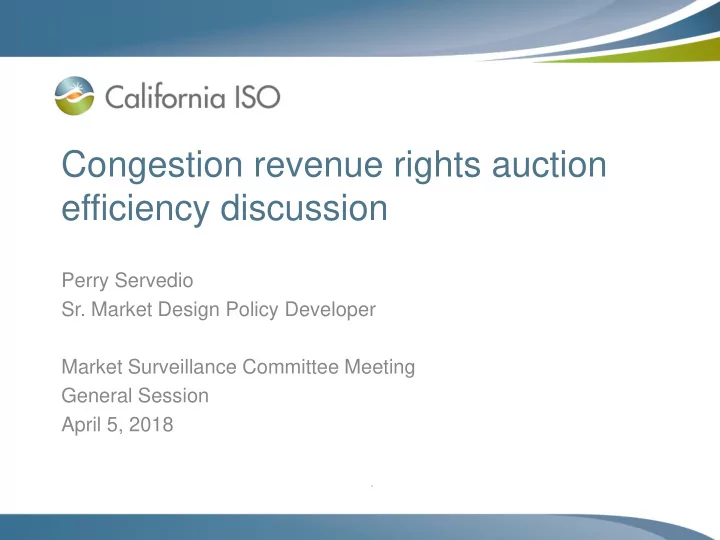

Congestion revenue rights auction efficiency discussion Perry Servedio Sr. Market Design Policy Developer Market Surveillance Committee Meeting General Session April 5, 2018 .
Roadmap for addressing congestion revenue rights auction efficiency • Track 0: Process changes under current authority – Ongoing • Track 1A: Measures in time for annual 2019 congestion revenue rights process – Adopted at March 2018 BOG – FERC filing this week • Track 1B: Measures in time for 2019 congestion revenue rights settlement – Target June BOG • Track 2: Potential comprehensive changes – 2020 congestion revenue rights implementation Page 2
Track 1B focuses on partial funding and other short implementation effort approaches • CAISO congestion revenue rights are currently fully funded – Auctioned rights provide a complete hedge – Auctioned rights always receive payment for the full difference in marginal congestion components • Other ISO/RTOs throughout the United States use various financial transmission rights partial funding methods – Auctioned rights share in payment shortfalls – Auctioned rights do not provide complete hedge • The CAISO will also consider approaches that could be implemented fairly quickly after receiving a FERC order and prior to 2019 auction Page 3
Certain partial funding approaches may disincentivize model gaming and highly speculative behavior in the auctions • Load-serving entities pay all shortfalls to fully fund auctioned congestion revenue rights • In a sense, there are two classes of congestion revenue rights – Fully funded auctioned congestion revenue rights – Partially funded allocated congestion revenue rights – Allocated rights on the same constraints as auctioned rights do not receive equivalent payouts • If all rights share shortfalls appropriately, all rights flowing on the same constraint receive an equivalent payout • If certain constraints were mostly purchased on a speculative basis – Holders of rights purchased to game model differences would pay back their share of the shortfall – Holders of low-value highly speculative rights would pay back their share of the shortfall Page 4
Partially funding congestion revenue rights ex ante versus ex post • In ex ante approaches, the ISO de-rates congestion revenue rights prior to the day-ahead market – Shape the congestion revenue rights quantity to the hourly granularity – Allows market participants to adjust forward energy positions prior to day-ahead market to be consistent with their final supply delivery hedge – Potential incentives for higher bid-values depending on de-rate method • In ex post approaches, the ISO charges congestion revenue rights holders for shortfalls after the day-ahead market – Shape the congestion revenue rights payouts to the hourly granularity – Payouts aligned with revenues collected in the day-ahead market – Potential to eliminate incentives to game model differences between the congestion revenue rights market and day-ahead market Page 5
Partially funding congestion revenue rights ex ante versus ex post • Under either ex ante or ex post approach, the ISO will not pay congestion revenue rights holders for the full quantity of the congestion revenue rights all the time • Participants likely will lower their bid values in anticipation of lower payouts • Are there any partial funding approaches that reduce the incentive for market participants to lower bid values in the auction? Page 6
Ex ante de-rate based on bid value • One day prior to day-ahead market, re-run the simultaneous feasibility test using the most recent day-ahead model – Most accurate model – Allow participants the opportunity to react to the de-rate • De-rate congestion revenue rights to hourly granularity based on available transmission and bid value – The ISO would de-rate lowest value congestion revenue rights first – Allocated congestion revenue rights would have priority in the adjustment process – Basing on bid values provides the incentive to not completely reduce bid values in auctions Page 7
Ex post payment reduction based on effectiveness • After the day-ahead market, calculate the revenue shortfall per constraint • Reduce payments to only those congestion revenue rights effective on specific constraints that generated the revenue shortfall Target CRR payout DAM limit CRR payout on constraint shortfall reduction Congestion revenues collected Page 8
Other approaches under consideration with potentially short implementation timelines • Lower the percentage of system capacity released in the annual congestion revenue rights process • DMM and Southern California Edison proposal to eliminate using the available transmission system in the auction • Implement reserve prices – Point-to-point based on historical day-ahead market congestion between nodes – Data analysis on impact on auction revenue shortfall of low- priced congestion revenue rights Page 9
Recommend
More recommend